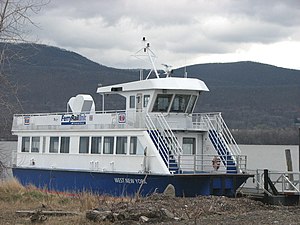Newburgh–Beacon Ferry

West New York moored at Newburgh
|
|
| Locale | Newburgh Bay |
|---|---|
| Waterway | Hudson River |
| Carries | passengers |
| Terminals |
Newburgh, Beacon, NY, United States |
| Operator | NY Waterway |
| Authority | MTA |
| Began operation | October 17, 2005 |
| System length | 1.75 miles (2.82 km) |
| Travel time | 10 minutes |
| No. of vessels | 1 (West New York) |
| Connections at Beacon | |
| Metro-North Hudson Line | |
| Dutchess County LOOP | |
The Newburgh–Beacon Ferry is a ferry service crossing the Hudson River that connects Newburgh with Beacon, New York.
It carries passengers between the two cities during rush hour, primarily transporting commuters from the west side of the river at Newburgh to the commuter train station on the east side at Beacon where they can catch Metro North Hudson Line service to Grand Central Terminal and other points in New York City.
NY Waterway operates the ferry under contract from the Metropolitan Transportation Authority, along with the Haverstraw–Ossining Ferry downstream. Service began in 2005 after the Newburgh-Beacon Bridge had, 42 years earlier, rendered over two centuries of ferry service obsolete.
The Beacon terminal is at a dock immediately adjacent to the station; the Newburgh terminal is at the south end of Front Street. The fare is $1 per person; the trip across the river takes approximately 10 minutes.
The commuter ferry is not a new idea. Tradition has it that Native Americans regularly crossed the Hudson River at the point between what is now Beacon and Newburgh, long before Europeans arrived in America. In 1743, an “official” ferry was established when Alexander Colden received a royal charter from King George II to carry passengers and goods for profit. The right to operate ferries between Beacon and Newburgh was bestowed upon the Ramsdell family by the heirs of Alexander Colden. They ran the ferry through the Steamboat Era until 1956 when NYSBA took over ferry services.
By the early 20th century the fleet had grown to three 160-foot (49 m) coal-fired ferries, the Orange, Dutchess and Beacon, capable of carrying 30 vehicles each. It linked the two segments of NY 52, the major east-west artery at that point.
...
Wikipedia
